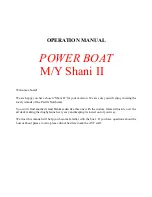
© TAKACAT GmbH - Friedel Hacker (Dipl.-Ing.)
Page
4
220 mbar of the front hose chambers. In practice it has been shown that 220 mbar is completely sufficient.
The maximum chamber pressure for the carrying/drive hoses must
not exceed 250 mbar
.
When the pumping process is finished, you must close the valves with the corresponding protective covers.
The hose chambers are equipped with safety overpressure valves so that any excess pressure can be
compensated. With the pressure gauge included in the delivery you can check the correct filling, or you can
use an electric pump with corresponding adjustment possibilities.
Always make sure that the valve adapter
is correctly locked and keep a proper distance during the pumping process, so that no injuries are caused if
the air hose should jump off!
Note - Fixation seam:
When you have inflated the driving tubes you will see a split seam. This seam is
not a defect but a so-called fixation seam, which is set during the production
process so that the connecting bottom can be glued at right angles to the two
driving hoses. When inflating, this fixation seam opens up and the separated
stitch threads can be seen, which rub away over time.
Step 4 (only applies to open transom):
4 Allen screws transom plate:
Fasten the transom plate to the four fastening tongues with the supplied
screws. The screws are guided from the inside to the outside through the fixing tongues into the transom
plate with a fitted retaining ring and a fitted washer, and are first screwed by hand into the press-in nuts at
the rear. Please make sure that the screws can be screwed into the nuts easily. Please make sure that there
is a retaining ring and a washer under each screw head. The final fixing is done with the help of the supplied
Allen wrench. Tighten the screws well by hand, do not use brute force when screwing them together.
Rear view mirror plates with central screw and ring nut:
Place the smaller rear view mirror plate with the
type plate on the stainless steel mountings of the transom tubes from the front. Then hold the larger
transom plate from behind against the transom tubes and insert the central fastening nut with a slipped on
spacer through the fastening hole. Coat the last threads of the fastening screw e.g. lightly with transparent
Liqui Moly lubricant. Then tighten the ring nut with a spacer washer by hand. Fix the central transom
mounting with a 17 mm socket wrench and a counter rod for the ring nut. Do not use brute force when
screwing it on. Greasing the threads serves to prevent the threads of the screw and ring nut from sticking,
which V4A stainless steel tends to do. You can find a video illustration at:
https://www.youtube.com/watch?v=BTRTezVRcF0&feature
When using a
Torqeedo Travel 503, 1003 or 1103,
a distance plate made of wood or plastic must be placed
between the inner transom plate and the pressure plates of the toggle screw connection so that the toggle
screw connections do not press into the upper transom rod. The minimum dimensions of the distance plate
are 140 x 40 x 10mm (width/height/depth).
When installing an outboard (short shaft), it is
essential to ensure that
the support plates of the toggle
fittings of the outboard mounting do not press in the upper transom rod and cause structural damage. If
necessary use a spacer plate (applies only to open transom). Camp3
www.camp3.eu) offers a plastic
distance plate which can be screwed under the stainless steel plate of the inner transom plate.
Outboards
with long shaft or extra long shaft must not be used. The transom tubes must not be used as towing
brackets. Only the tow rings in the stern and bow area are used for towing. In order to avoid damage, it is
essential to ensure gentle gas changes.
Step 5:
Place the two black floor end tabs on the left and right over the lower transom mount and close the
respective Velcro fasteners. The middle bottom flap is used for drainage and is simply led outwards below
the transom mount.





























